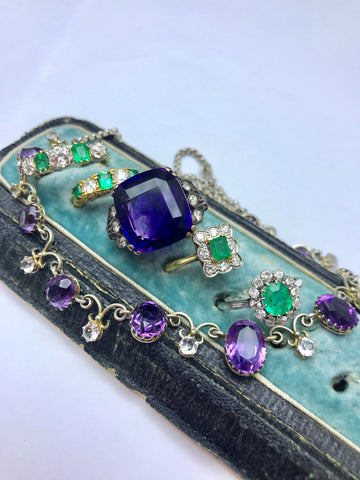The move for women to have the vote started around 1897 when Millicent Fawcett founded the National Union of Women’s Suffrage. “Suffrage” means the right to vote and that is what women wanted.
From 1908, the WSPU adopted the colour scheme of purple, white and green: purple symbolised dignity, white purity, and green hope. These three colours were used for banners, flags, rosettes and badges, They would also carry heart shaped vesta cases, and appeared in newspaper cartoons and postcards.

Mappin and Webb, the London jewellers, issued a catalogue of suffragette jewellery for Christmas 1908. In the same year there was a new law introduced to limit the size of hat pins. Fearing that the suffragette women would use their hat pins as weapons, it specified that a hat pin should limited to 9”, from end to end.
In 1909 the WSPU presented specially commissioned pieces of jewellery to leading suffragettes Emmeline Pankhurst and Louise Eates. Some Arts and Crafts jewellery of the period incorporated the colours purple, white and green using enamel and semi-precious stones such as amethysts, pearls, peridots. Precious stones such as emeralds, diamonds were worn by the upper-classes.
Selfridge’s opened its glamorous, purpose-built store in Oxford Street on 15 March 1909. Selfridges advertised regularly in the suffragette paper Votes for Women, and designed clothes for the women to wear at their demonstrations. Huge numbers of women would turn out for these demonstrations and create a tricolor tide overtaking the streets of London.

There is another kind of jewellery legitimately associated with the suffragette movement: and that is the Holloway brooch. These rare and interesting pieces were designed by Sylvia Pankhurst and presented to certain suffragettes to mark their releases from Holloway prison. The design incorporates a portcullis symbol of the House of Commons, and convict symbol and hanging chains with a purple, white, and green ribbon superimposed on the front






